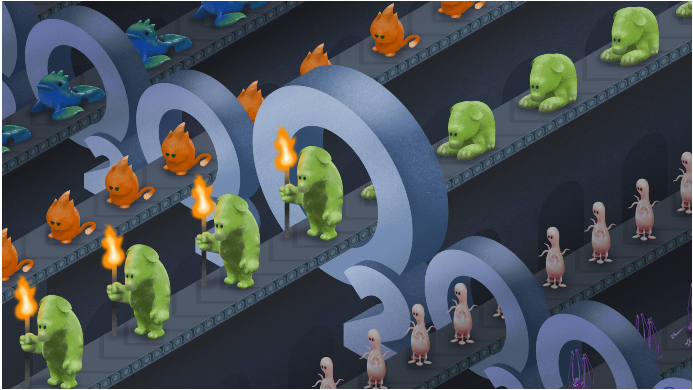Astrophysicist Adam Frank of the University of Rochester investigates the connections between atmospheric oxygen and finding evidence of alien technology on far-off planets.
 AIR SUPPLY: Coined by astrophysics Adam Frank and Amedeo Balbi, the “oxygen bottleneck” describes the critical threshold that separates worlds capable of fostering technological civilizations from those that fall short. “Without a ready source of fire, you’re never going to develop higher technology,” says Frank. Image Credit: University of Rochester illustration / Michael Osadciw
AIR SUPPLY: Coined by astrophysics Adam Frank and Amedeo Balbi, the “oxygen bottleneck” describes the critical threshold that separates worlds capable of fostering technological civilizations from those that fall short. “Without a ready source of fire, you’re never going to develop higher technology,” says Frank. Image Credit: University of Rochester illustration / Michael Osadciw
In the pursuit of comprehending the possibility of extraterrestrial life, scientists are expanding their investigation to include technical as well as biological indications. Although oxygen is essential for life as we know it, astrobiologists might be able to use it to unleash cutting-edge planetary technologies.
Amedeo Balbi, an Associate Professor of Astronomy and Astrophysics at the University of Roma Tor Vergata, Italy, and Adam Frank, the Helen F. and Fred H. Gowen Professor of Physics and Astronomy at the University of Rochester and author of The Little Book of Aliens (Harper, 2023), outline the connections between atmospheric oxygen and the possible emergence of advanced technology on distant planets in a new study published in Nature Astronomy.
We are ready to find signatures of life on alien worlds. But how do the conditions on a planet tell us about the possibilities for intelligent, technology-producing life?
Adam Frank, Helen F. and Fred H. Gowen Professor, Physics and Astronomy, University of Rochester
Balbi stated, “In our paper, we explore whether any atmospheric composition would be compatible with the presence of advanced technology. We found that the atmospheric requirements may be quite stringent.”
Igniting Cosmic Technospheres
Frank and Balbi argue that oxygen is essential for the development of fire, which is a sign of a sophisticated society, in addition to being necessary for respiration and metabolism in multicellular creatures. The notion of “technospheres,” vast spheres of sophisticated technology that give off telltale indicators of extraterrestrial intelligence, or “technosignatures,” is explored.
The evolution of civilization on Earth required easy access to open-air combustion, the fundamental process of fire, which involves the burning of fuel and an oxidant (typically oxygen). Burning fuels has been the engine of industrial society for many purposes, including cooking, forging metal for buildings, creating building materials, and generating electricity.
Looking back into Earth’s past, scientists discovered that it was only at or above 18 percent atmospheric oxygen that allowed for the regulated use of fire and the ensuing advances in metallurgy. This implies that only planets with high oxygen contents will be able to create sophisticated technospheres and, consequently, leave behind observable technosignatures.
The Oxygen Bottleneck
A species might be able to survive in an oxygen-free environment, but it will not be able to develop into a technological species because the amounts of oxygen needed to support complex life and intellect are not as high as those needed for technology, the researchers claim.
Frank added, “You might be able to get biology—you might even be able to get intelligent creatures—in a world that doesn’t have oxygen but without a ready source of fire, you are never going to develop higher technology because higher technology requires fuel and melting.”
Enter the “oxygen bottleneck,” as the researchers have termed the key point that divides worlds that are able to support sophisticated civilizations from those that are not. In other words, the development of cutting-edge technology is hampered by oxygen levels.
“The presence of high degrees of oxygen in the atmosphere is like a bottleneck you have to get through in order to have a technological species. You can have everything else work out, but if you don’t have oxygen in the atmosphere, you’re not going to have a technological species,” Frank further stated.
Targeting Extraterrestrial Hotspots
The study emphasizes the importance of giving planets with high oxygen levels priority when looking for extraterrestrial technosignatures since it tackles a hitherto unstudied aspect of the cosmic hunt for intelligent life.
Frank noted, “Targeting planets with high oxygen levels should be prioritized because the presence or absence of high oxygen levels in exoplanet atmospheres could be a major clue in finding potential technosignatures.”
Balbi concluded, “The implications of discovering intelligent, technological life on another planet would be huge. Therefore, we need to be extremely cautious in interpreting possible detections. Our study suggests that we should be skeptical of potential technosignatures from a planet with insufficient atmospheric oxygen.”
A NASA grant helped to partially finance the project.
Journal Reference:
Balbi, A., et. al. (2023) The oxygen bottleneck for technospheres. Nature Astronomy. doi:10.1038/s41550-023-02112-8